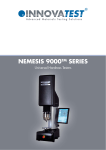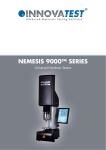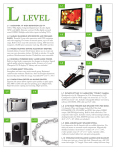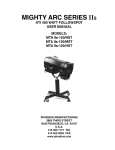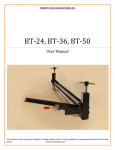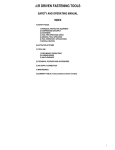Download Woodshop Safety Manual
Transcript
College of Architecture Safety Manual Contents I. II. III. IV. General a. Woodshop Use b. Procedures c. Safety d. Emergency Facilities a. Woodshop Stationary Tool Safety a. Band Saw b. Belt/Disc Sander c. Spindle Sander d. Compound Miter Saw e. Drill Press f. Jointer Hand Tool Safety a. Belt Sander b. Circular Saw c. Detail Sander d. Drill e. Finishing Sander f. Grinder g. h. i. j. k. Panel Saw Planer Scroll Saw Table Saw Wood Lathe g. h. i. j. k. l. Jig Saw Oscillating Spindle Sander Plate Joiner Pneumatic guns Random Orbital Sander Routers Warning: Knowledge and understanding of rules and procedures are your responsibility. Woodshop supervisor holds all rights to change and/or modify at any time or for any specific situation. All things are strictly enforced. 2 General a. Woodshop Use a. College of Architecture Students, Faculty, and Staff The woodshop is available for class projects. b. Woodshop Access Privileges will be extended after the completion of the safety course. c. Equipment access Safety clearance allows access to any machine or tool you are knowledgeable in. If you do not know the correct way to use a tool or machine ask for help. Misuse or abuse of a tool will suspend its availability. b. Procedures a. Safety Course Each person must watch the woodshop safety video, complete the safety quiz, and sign the User Safety Agreement. Each of these will be available online at . The safety quiz and user agreement must then be submitted to the woodshop supervisor in order for the quiz to be graded and the user agreement to be signed by the woodshop supervisor. b. Tool check out tools will be checked out to individuals by the woodshop supervisor. You will only be issued tools you are authorized to use. Excess tools should be returned before new tools will be issued. c. Clean up Your work area must be clean before you leave. Due to minimal storage space in the woodshop, projects should be stored in your studio. Failure to properly clean your workspace may void woodshop privileges. d. Check out Any tool you have checked out must be returned to woodshop personnel and any mess you have made must be cleaned up. 3 c. Safety a. Accidents‐ Report everything! We need to know for your safety. Inform Supervisor or Trained Personnel as soon as possible. Minor incidents are important. Accidents include any personal harm or any damage done to machines or tools. b. Danger‐ Anything that appears to be an immediate or potential hazard should be dealt with immediately. Damaged equipment should be reported. c. Electrical Hazards‐ Keep out of any electrical control boxes. d. Moving Parts‐ Always keep your hands and other extremities away from all moving parts. e. Eye Protection Imperative when working with or around any tools and machinery, even if you are not using the equipment. Eye protection must be worn at ALL times when you are in the shop. This is the law; there are no exceptions! f. Face Shields Required when using lathe, but advised for all machinery. g. Ear Protection Available and advised. h. Dust Mask Available upon request. Whenever working with wood, dust is produced and can be a hazard. Certain woods could contain harmful chemicals and Western Red Cedar has been attributed to asthma and nasal cancer. Wear mask when creating high levels of saw dust and always keep work area clean. i. Clothing‐ 1. Long hair must be pulled back and secured. 2. No loose clothing. Long sleeves should be rolled up and shirt tails should be tucked in. 3. Must be wearing full‐length pants. 4. Shoes must be rubber soled and closed toed, No sandals, etc. 5. No jewelry can be worn, including watches and dangling earrings. 6. Backpacks and other belongings must be stored outside woodshop area. j. No Food, Drinks, tobacco, alcohol, or drugs, legal or otherwise This and all A&M facilities are smoke‐free. k. Respect your peers and faculty Be considerate and helpful towards each other. No running, yelling, or other horseplay allowed. l. Electronics No headphones or cellular devices. 4 d. Emergency a. Emergency Shut Down For use only in an emergency. These buttons cut power to all machines and outlets in the woodshop. Shut down switches are on all four walls. b. Fire Emergency pull is located to the right of the overhead door. Extinguishers are throughout the shop. c. First Aid first aid is located next to office window. Have personnel assist you with all injuries. d. Emergency Assistance Dial 9911 on campus phones. 5 II. Facilities a. Woodshop This area houses all the stationary tools that are connected to the sawdust vacuum collection system. Four worktables are equipped with electrical outlets for hand tools and quick release vises to secure projects. Chemical use is not allowed in this room, this is a fire hazard. Supervision by trained personnel is required. 6 III. Stationary Tool Safety 1. Use machines only as intended. If in doubt, ask for assistance and/or refer to user manual. 2. You should be informed in operation and safety procedure. If you are not comfortable with a machine, do not use it; ask for assistance. 3. Focus on your work. Look, listen, and be in control of what you are doing. Do not be distracted by or talk to others and do not distract others. 4. Avoid accidental starting. 5. All Safety guards and devices must be in place when operating machines. 6. Do not overreach. 7. Machine must be at rest before removing byproducts and turned “off” before leaving. 8. Return adjustable parts to rest position. Machine should be clean and clear before, during, and after it is used. 9. Red knobs are not for adjustments. These are for calibrations that should only be done by Supervisor. 10. Make all adjustments with the power box switched off! . 11. All adjustable parts should be secure before power is on. 12. Do not use force. The tool should do the work. If it does not perform as you expect, let trained personnel know. There may be a better way. 13. Stay within reach of power switch at all times. 14. Check for worn and damaged parts. Let trained personnel correct these problems. Do not attempt it yourself. 15. Machinery should not be used to cut used lumber, plaster, or drywall. 7 a. Band Saw‐ Free‐hand tool designed for cutting circles and curves. Can also be used to rip and crosscut relatively small pieces of wood. Safety Eye protection is required by law. Do not be distracted by or talk to others when operating machinery. 1. 2. 3. 4. 5. 6. 7. 8. Always keep hands and fingers 3” away from the cutting edge. Upper guide should be only 1/8” above material height. Only use wood that has flat surfaces. Hold wood firmly feeding it into blade at a moderate speed. Check band for good tension. Avoid backing wood out of an incomplete cut. Blade inhibits tight turns that could twist and break band. Clicking while blade is in motion indicates a hazard. Inform trained personnel. b. B el t/ D is c Sander‐ Free‐hand tool for sanding small pieces of wood. Safety Eye protection is required by law. Do not be distracted by or talk to others when operating machinery. 1. Sand only in the direction of the wood grain on the downward stroke of the machine. 2. Do not apply excessive force. 3. Check sanding surfaces for tears or holes. Worn surfaces should be replaced. 4. Check belt traction while running. 5. Gloves should not be worn, neither should you hold object with rag. 8 9 c. Spindle Sander Used for sanding curved surfaces. Safety Eye protection is required by law. Do not be distracted by or talk to others when operating machinery. 1. Sanding spindle should be appropriate size for the radius of the curve you need to sand. 2. Keep wood flat on table while sanding. 3. Do not apply excessive force. 4. Check sanding surfaces for tears or holes. Worn surfaces should be replaced. 10 d. Compound Miter Saw‐ 10” Compound Slide Miter Saw‐ Used for cross cuts, miter and compound miter jointing. Safety Eye protection is required by law. Do not be distracted by or talk to others when operating machinery. 1. Blade should be sharp, run freely, and be free of vibration. 2. Let blade come to full speed before beginning cut. 3. Hold material with hand away from blade and keep your fingers and thumb together. 4. Do not cross your arms while using the saw. 5. Start the saw, pull out, push down, and push back. 6. Allow blade to stop completely before lifting up. 7. Do not attempt to cut small pieces. 8. Do not handle blade guard. It is designed to self‐retract. 11 e. Drill Press‐ 15” Variable Speed‐ Designed to make vertical holes or create mortises. Safety Eye protection is required by law. Do not be distracted by or talk to others when operating machinery. 1. Larger bits should be used at slower speeds. 2. Adjust speed with motor running. 3. Place scrap stock underneath material to be cut in order to protect base. 4. Clamp plastic and metal to base. 12 f. Jointer‐ 8” Long Bed for squaring and shaving along the edge grain. Safety Eye protection is required by law. Do not be distracted by or talk to others when operating machinery. 1. Use a push block whenever project goes over the cutting surface keeping fingers 4” from the cutting knives. 2. Wood should be more than 6” long. 3. Never adjust outgoing table. 4. Feed against blade rotation. Reverse direction can cause serious injury. 13 g. Panel Saw Ripping and crosscutting large sheets. Safety Eye protection is required by law. Do not be distracted by or talk to others when operating machinery. 1. Blade should be at full speed before beginning cut. 2. Slowly return saw motor to the top and tighten it down. Never let go until it is secure. 3. Be aware of the power cord that is does not fall into path of the blade critical when returning blade to top. 14 h. Planer‐ Designed to plane stock to any thickness smoothly. This machine cannot straighten bows or warps. Safety Eye protection is required by law. Do not be distracted by or talk to others when operating machinery. 1. 2. 3. 4. 5. 6. 7. 8. Use only with personnel assistance. Plane off only 1/16” each pass. Keep others out of line of input and output of table. Plane only clean clear wood. Any imperfections in the wood should be checked first. Only one piece of wood at a time. Do not start a second until first is clear and do not stack. If board stops moving, turn power off immediately, lower deck, and get trained personnel. Clear dust and woodchips with brush not hand. Feed against blade rotation. Reverse direction can cause serious injury. 15 i. Scroll Saw Free‐hand tool for cutting fine detail designs. Safety Eye protection is required by law. Do not be distracted by or talk to others when operating machinery. 1. 2. 3. 4. 5. 6. Be sure adjustment keys and wrenches have been removed. Rotate motor once by hand before use. Lower hold down clamp against wood to secure it. Only use ½” stock wood or smaller that has flat only surfaces. Hold wood firmly feeding it into blade at a moderate speed. Blades should be changed by personnel but always check band for good tension. 7. Stop blade before backing wood out of an incomplete cut. 8. Make release cuts before making long curves. 16 j. Table Saw Ripping and Crosscutting stock. Safety Eye protection is required by law. Do not be distracted by or talk to others when operating machinery. 1. Use a push block whenever project goes over the cutting surface. Keep hands at least 4” from blade. 2. Stand to side of wood being ripped. 3. Stay within reach of power switch. 4. Only use one fence or miter guage. 5. Be sure adjustment wrenches or any other objects have been removed from table before use. 6. Hold wood firmly feeding it into blade at a moderate speed. Push wood with a push stick until it clears cutting blade. 7. This in not a free‐hand machine. Always use a fence or miter gauge. 8. Feed against rotation. Wrong way will accelerate wood and cause damage. 9. No dead‐cuts. Continue ripping all the way through your board without stopping. 10. Only use wood that has flat surfaces. 11. Only one piece of wood at a time. Do not start a second until first is clear. 17 Wood Lathe Milling original, symmetrical wood profiles. Safety Eye protection is required by law. Do not be distracted by or talk to others when operating machinery. 1. Tool rest should be at proper height and as close to work as possible. 2. Vary speed with motor running. 3. Only certain types of wood can be milled. Check wood with trained personnel if unsure. 4. Check for clearance and balance before beginning. 5. Tailstock should be tight. 6. Turning tool should not interfere with work. 7. Do not jam tool into work, especially during rough turning. 8. Disengage index pin before beginning. 9. Refer to chart to determine speed. 18 IV. Hand tool Safety 1. Use tools only as intended. If in doubt, ask for assistance and/or refer to user manuals. 2. You should be informed in operation and safety procedure. If you are not comfortable with a machine, do not use it; ask for assistance. 3. Focus on your work. Look, listen, and be in control of what you are doing. Do not be distracted by or talk to others and do not distract others. 4. All safety guards and devices must be in place when operating tools. 5. Avoid accidental starting. 6. Tool should be at rest before removing byproduct and laying it down. Unplug a tool that is not being used. 7. Unplug tool before changing parts and making adjustments. Be sure bits and blades are secure before usage. Turn switch to “OFF” before plugging into socket. 8. Return adjustable parts to rest position. Machine should be clean and clear before, during, and after it is used. 9. Do not use force. The tool should do the work. If it does not perform as you expect, let trained personnel know. There may be a better way. 10. Do not overreach. 11. Extension cords must be 3‐prong grounded or polarized. If a 2‐prong cord will not fit, flip it over. 12. Pull plug out from sockets by the grip not the cord. 13. Use clamps and vises to hold down wood or metal. Keep your hands free to control the hand tool. 14. Cords can be electrocution hazards. Be sure they run behind you, out of the tools direction. 15. Hold by insulated gripping for greater shock protection. 16. Check for worn and damaged parts. Let trained personnel correct these problems. Do not attempt it yourself. 17. Wood should be flat and clear of all foreign objects. 19 a. Belt Sander‐ This tool is designed to smooth larger items like rough boards, old finishes, and sometimes metal and plastic. Safety Eye protection is required by law. Do not be distracted by or talk to others when operating tools. 1. Hold with both hands. This tool is easy to loose control of. 2. Belt must be tracked properly before use. 3. The weight of the sander is sufficient. Leaning on the tool is bad for the motor and is less effective. b. Circular Saw Hand ripping and Crosscutting stock. Safety Eye protection is required by law. Do not be distracted by or talk to others when operating tools. 1. Hold with both hands. This tool is easy to loose control of. 2. Blade guard is designed to self‐ retract. 20 c. Detail Sander‐ This tool provides the ability to sand in corners and in other detailed spaces. Safety Eye protection is required by law. Do not be distracted by or talk to others when operating tools. 1. A moderate grip on the sander is sufficient. Excessive force is bad for the motor and is less efficient. d. Drill‐ This tool is designed to drill various sized straight holes into wood or metal. Safety Eye protection is required by law. Do not be distracted by or talk to others when operating tools. 1. Drill straight in and pull straight out. Twisting or wobbling bit in a hole will damage the bit and cause bodily harm. 2. Bits can be extremely hot after use. 3. Be sure to drill with motor in forward direction. Reverse direction will burn or can ignite wood. 4. Pull bit out of deep holes to remove debris. Excess chips can cause overheating. 21 Finishing Sander‐ Half and quarter sheet sanders for finishing flat surfaces. Safety Eye protection is required by law. Do not be distracted by or talk to others when operating tools. 1. The weight of the sander is sufficient. Excess pressure on the tool is bad for the motor and is less effective. 2. Abrasive paper should be secure before use. e. Grinder‐ This is a metal working tool for grinding, and smoothing rough edges. Safety Eye protection is required by law. Do not be distracted by or talk to others when operating tools. 1. Hold with both hands. This tool is easy to loose control of. 2. Lay tool trigger and grinder side up. 3. Always position wheel guard between you and your work. 22 f. Jig Saw‐ This tool is generally used for pattern cutting into materials with the maximum thickness of 4 1/4” for wood and1¼” for plastic and fiberglass, refer to manual for metal thickness. Safety Eye protection is required by law. Do not be distracted by or talk to others when operating tools. 1. Find a clear area to work with this tool and secure the material. 2. Keep base on flat surface when in use. 3. Do not use a bent blade. g. Oscillating Spindle Sander‐ This tool is designed to sand edges and ideal for inside cutouts and curves. Safety Eye protection is required by law. Do not be distracted by or talk to others when operating tools. 1. Hold with both hands. 2. A moderate grip on the sander is sufficient. Excessive force is bad for the motor and is less efficient. 3. This tool is not for removing material. Only sanding. 23 h. Plate Joiner‐ This tool is designed specifically to cut slots in wood for biscuit joining. It will cut sizes “FF,” “0,” “10,” and “20” at 5/32” thickness. Safety Eye protection is required by law. Do not be distracted by or talk to others when operating tools. 1. Hold with both hands. This tool is easy to loose control of. 2. This is not free‐hand. Do not attempt to move tool when in place for cut. 3. Release pressure slowly after cut. 24 i. Pneumatic Guns‐ Fastening with brads, staples, finishing and framing nails. Safety Eye protection is required by law. Do not be distracted by or talk to others when operating tools. 1. Material must be sufficient enough to withstand impact of tool. 2. Never point this in the direction of another person. Also, no one should be in front of operator in case of error. 3. This tool is not to be used in any way other than intended. 4. Do not tamper with contact element. 5. The air hose is the power, disconnect when reloading or adjusting. j. Random Orbital Sander‐ This palm‐sized sander removes material more rapidly than a finish sander. Safety Eye protection is required by law. Do not be distracted by or talk to others when operating tools. 1. A moderate grip on the sander is sufficient. Excessive force is bad for the motor and is less efficient. 2. Abrasive paper should be secure before use. 3. This tool is capable of abrasions unlike finishing sanders. 25 k. Routers‐ Used for milling and shaping wood edges and free forms. Safety Eye protection is required by law. Do not be distracted by or talk to others when operating tools. 1. Hold with both hands. This tool is easy to loose control of. 2. Bits can be extremely hot after use. 3. Keep base on flat surface for smooth cuts. 4. Make progressive cuts to desired depth. 5. Speed should be reduced for larger bits. 6. Do not “Climb‐cut.” Cut outside edges counter‐ clockwise and inside edges clockwise. 26 Golden Rules of the Woodshop Because your mother isn’t here! If you open it . . . Close it If you turn it on . . . Turn it off If you unlock it . . . Lock it If you checked it out . . . You must check it in Take care of it If you use it . . . If you break it . . . Report it Return it If you borrowed it . . . If you glued it . . . Tag it with date and time Clean it up If you make a mess . . . If it is in the way . . . Move it If you moved it . . . Put it back If you are confused . . . Ask for help If you are unable to operate it . . . Leave it alone If it does not concern you . . . It’s none of your business 27



























